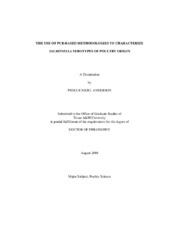| dc.description.abstract | Three studies were conducted to investigate the use of molecular techniques to
identify Salmonella serotypes in poultry. In the first experiment, two polymerase chain
reaction (PCR)-based techniques: denaturing gradient gel electrophoresis (DGGE) and
polyacrylamide gel electrophoresis (PAGE) were used to analyze Salmonella serotype
isolates from two turkey processing plants (A and B). Genotypic patterns of each isolate
were compared with those of known serotypes identified by traditional antibody
precipitation methods. In Plant A, four different Salmonella serotypes were identified:
Derby, Hadar, Montevideo, and Senftenberg. In plant B, ten serotypes were identified:
Agona, Anatum, Brandenburg, Derby, Hadar, Meleagridis, Montevideo, Reading,
Senftenberg, and Typhimurium. S. Derby was predominant in Plant A (83%) while S.
Typhimurium was the most common serotype recovered in Plant B (39%). Overall,
DGGE was more sensitive than PAGE. Isolates of the same serotypes were all grouped
together by DGGE, while PAGE failed to group all like serotypes. Next, DGGE and REP-PCR were used as genotyping tools for identifying
Salmonella. Fifty-four Salmonella isolates from two turkey processing plants (A and B)
were evaluated. The isolates were comprised of the following serotypes: Brandenburg,
Derby, Hadar, and Typhimurium (n = 6, 21, 12, and 15, respectively). Both methods
were very sensitive and detected diverse fingerprint profiles among the isolates. The data
suggested that REP-PCR and DGGE are useful tools for identifying Salmonella
serotypes in research trials of this type.
The final trial was carried out to track Salmonella serotypes throughout an
integrated poultry operation using DGGE. Four flocks were sampled from grow-out
through processing. The data showed that there was correlation between Salmonella
serotypes found on processed carcasses and during grow-out. In addition, the isolates
were compared against 15 known serotypes in our data base and only S. Hadar from the
data base matched the unknown Salmonella isolates.
Overall, these studies demonstrate that PCR-based methods could be considered
as an alternative to conventional methods of antibody-based serotyping. Molecular
methods were found to be reliable, sensitive, inexpensive, reproducible, and less labor
intensive than conventional methods. | en |


